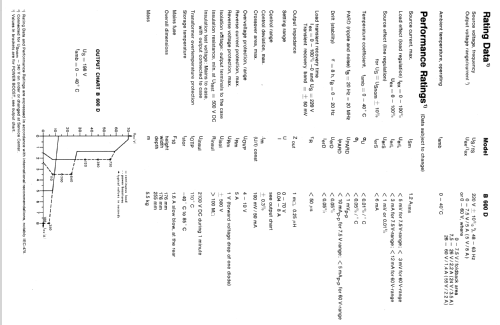Power Supply LABPAC B600D
Oltronix AB; Vällingby
- País
- Suecia
- Fabricante / Marca
- Oltronix AB; Vällingby
- Año
- 1977 ?
- Categoría
- Aparato de medida y servicio (Equipo de laboratorio).
- Radiomuseum.org ID
- 247287
Haga clic en la miniatura esquemática para solicitarlo como documento gratuito.
- Numero de transistores
- Hay semiconductores.
- Semiconductores
- Gama de ondas
- - no hay
- Tensión de funcionamiento
- Red: Corriente alterna (CA, Inglés = AC) / 110; 117; 220; 235 Volt
- Altavoz
- - - No hay salida de sonido.
- Material
- Metálico
- de Radiomuseum.org
- Modelo: Power Supply LABPAC B600D - Oltronix AB; Vällingby
- Forma
- Sobremesa de cualquier forma, detalles no conocidos.
- Ancho, altura, profundidad
- 176 x 176 x 255 mm / 6.9 x 6.9 x 10 inch
- Anotaciones
-
A single voltage power supply with POWER BOOST* and DIGITAL SETTING
• Output: 0 — 10V up to 5A or 0 — 70V up to 1.4A with Autorange: max. output current switched electronically as a function of output voltage
• DIGITAL SETTING and readout of the output with an accuracy of ± 0.3% by means of a 10-turn precision potentiometer. This is a valid substitute for an extra DVM measuring the output voltage
• Adjustable current limit from 0.04 — 8A
• Low source and load effect, low PARD (ripple and noise)
• Switchable overvoltage protection, variable from 4 — 10 V, active state indicated by LED
• Short circuit proof
• Two separate instruments for simultaneous reading of voltage and current
• Operating mode displayed by LEDs: constant voltage or constant current
• Mains transformer with overtemperature protection (OTP)
*POWER BOOST
This is the capability of delivering temporarily output currents up to 60% above the nominal value at full regulation accuracy. Electronic temperature monitoring of the case limits, if necessary, the output currents to its nominal value.
- Peso neto
- 5.5 kg / 12 lb 1.8 oz (12.115 lb)
- Mencionado en
- -- Original prospect or advert
- Autor
- Modelo creado por Pius Steiner. Ver en "Modificar Ficha" los participantes posteriores.
- Otros modelos
-
Donde encontrará 26 modelos, 26 con imágenes y 22 con esquemas.
Ir al listado general de Oltronix AB; Vällingby

